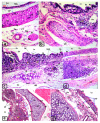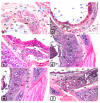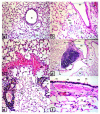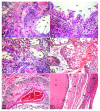Impact Effect of Methyl Tertiary-Butyl Ether "Twelve Months Vapor Inhalation Study in Rats"
- PMID: 31861902
- PMCID: PMC7168921
- DOI: 10.3390/biology9010002
Impact Effect of Methyl Tertiary-Butyl Ether "Twelve Months Vapor Inhalation Study in Rats"
Abstract
We investigated the early risk of developing cancer by inhalation of low doses (60 µL/day) of methyl tertiary butyl ether (MTBE) vapors using protein SDS-PAGE and LC-MS/MS analysis of rat sera. Furthermore, histological alterations were assessed in the trachea and lungs of 60 adult male Wistar rats. SDS-PAGE of blood sera showed three protein bands corresponding to 29, 28, and 21 kDa. Mass spectroscopy was used to identify these three bands. The upper and middle protein bands showed homology to carbonic anhydrase 2 (CA II), whereas the lower protein band showed homology with peroxiredoxin 2. We found that exposure to MTBE resulted in histopathological alterations in the trachea and the lungs. The histological anomalies of trachea and lung showed that the lumen of trachea, bronchi, and air alveoli packed with free and necrotic epithelial cells (epithelialization). The tracheal lamina propria of lung demonstrated aggregation of lymphoid cells, lymphoid hyperplasia, hemorrhage, adenomas, fibroid degeneration, steatosis, foam cells, severe inflammatory cells with monocytic infiltration, edema, hemorrhage. Occluded, congested, and hypertrophied lung arteries in addition, degenerated thyroid follicles, were observed. The hyaline cartilage displayed degeneration, deformation, and abnormal protrusion. In conclusion, our results suggest that inhalation of very low concentrations of the gasoline additive MTBE could induce an increase in protein levels and resulted in histopathological alterations of the trachea and the lungs.
Keywords: LC-MS/MS analysis; MTBE; cancer biomarker; histopathology.
Conflict of interest statement
The authors declare no conflict of interest in the assessment of results from this experiment.
Figures





Similar articles
-
The uptake, distribution, metabolism, and excretion of methyl tertiary-butyl ether inhaled alone and in combination with gasoline vapor.J Toxicol Environ Health A. 2003 Jun 13;66(11):1029-52. doi: 10.1080/15287390306398. J Toxicol Environ Health A. 2003. PMID: 12775515
-
MTBE inhaled alone and in combination with gasoline vapor: uptake, distribution, metabolism, and excretion in rats.Res Rep Health Eff Inst. 2001 May;(102):73-94; discussion 95-109. Res Rep Health Eff Inst. 2001. PMID: 11504149
-
Health assessment of gasoline and fuel oxygenate vapors: immunotoxicity evaluation.Regul Toxicol Pharmacol. 2014 Nov;70(2 Suppl):S43-7. doi: 10.1016/j.yrtph.2014.04.010. Epub 2014 May 2. Regul Toxicol Pharmacol. 2014. PMID: 24793263
-
Disposition, metabolism, and toxicity of methyl tertiary butyl ether, an oxygenate for reformulated gasoline.J Toxicol Environ Health. 1996 Apr 5;47(5):453-64. doi: 10.1080/009841096161609. J Toxicol Environ Health. 1996. PMID: 8614015 Review.
-
Methyl tertiary-butyl ether: studies for potential human health hazards.Crit Rev Toxicol. 2006 Apr;36(4):319-58. doi: 10.1080/10408440600569938. Crit Rev Toxicol. 2006. PMID: 16809102 Review.
Cited by
-
Systematic evaluation of the evidence base on methyl tert-butyl ether supporting a lack of concern for carcinogenic hazard in humans based on animal cancer studies and mechanistic data.Curr Res Toxicol. 2025 Feb 16;8:100224. doi: 10.1016/j.crtox.2025.100224. eCollection 2025. Curr Res Toxicol. 2025. PMID: 40084233 Free PMC article. Review.
References
-
- Komex, International Ltd. Water Quality Guidelines for Methyl Tertiary Butyl Ether (MTBE) British Colombia Ministry of Environment, Lands & Parks Water Management Branch; Alberta, BC, Canada: 2001.
-
- Fowler D.R. Master’s Thesis. The Evergreen State College; Olympia, WA, USA: Mar, 2011. An Analysis and Comparison of Methyl Tertiary Butyl Ether’s (MTBE’S) Use as a Fuel Oxygenate against the Tenets of the Precautionary Principle.
Grants and funding
LinkOut - more resources
Full Text Sources
Research Materials

